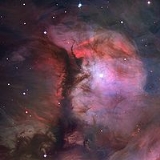
Messier 43
Encyclopedia
Messier 43 is an H II region
in the Orion constellation. It was discovered by Jean-Jacques Dortous de Mairan before 1731. The De Mairan's Nebula is part of the Orion Nebula
, separated from the main nebula by a lane of dust
. It is part of the much larger Orion Molecular Cloud Complex
.
H II region
An H II region is a large, low-density cloud of partially ionized gas in which star formation has recently taken place. The short-lived, blue stars forged in these regions emit copious amounts of ultraviolet light, ionizing the surrounding gas...
in the Orion constellation. It was discovered by Jean-Jacques Dortous de Mairan before 1731. The De Mairan's Nebula is part of the Orion Nebula
Orion Nebula
The Orion Nebula is a diffuse nebula situated south of Orion's Belt. It is one of the brightest nebulae, and is visible to the naked eye in the night sky. M42 is located at a distance of and is the closest region of massive star formation to Earth. The M42 nebula is estimated to be 24 light...
, separated from the main nebula by a lane of dust
Dust
Dust consists of particles in the atmosphere that arise from various sources such as soil dust lifted up by wind , volcanic eruptions, and pollution...
. It is part of the much larger Orion Molecular Cloud Complex
Orion Molecular Cloud Complex
The Orion Molecular Cloud Complex refers to a large group of bright nebula, dark clouds, and young stars located in the constellation of Orion. The cloud itself is between 1,500 and 1,600 light-years away and is hundreds of light-years across...
.

